“Out of the bosom of the Air,/Out of the cloud-folds of garments shaken,/Over the woodlands brown and bare,/Over the harvest-fields forsaken,/Silent, and, soft, and slow/ Descends the snow.” – Henry Wadsworth Longfellow (1807-1902)
As Longfellow’s poem, “Snow-flakes” suggests, through the centuries artists and poets have demonstrated the rich potential of the winter landscape to convey beauty as well as complex emotions and ideas.
These sorts of “top ten” selections are always somewhat arbitrary; many different artists of the fluffy stuff could replace those here. This selection favors American Impressionists working in oil, especially those who made a specialty of painting snow in or around New England. Many nineteenth-century landscapists not particularly known for snow but responsible for marvelous snow paintings would show here well, too; there’s Frederick Church, George Inness, and Birge Harrison to name three.
And any number of contemporary painters of snow could be included here as well. But I’ve restricted our list to artists whose reputations as masters of the snow-scape have lived on after their passing.
So – let it snow. Each of these artists makes of snowfall what Longfellow called “a poem of the air/Slowly in silent syllables (or brushstrokes!) recorded.”
Childe Hassam
Boston’s Childe Hassam is responsible for one of the world’s most beloved depictions of a snowy evening.
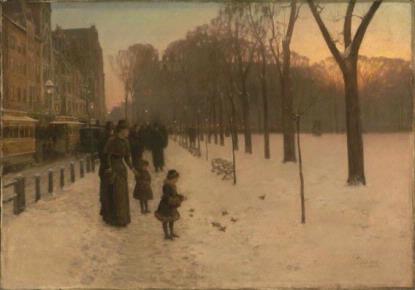
Childe Hassam, Boston Common at Twilight, 1885-86
“Boston Common at Twilight” hangs in the MFA. The warm glow that suffuses the snow wonderfully supports the sentiment associated with the girls feeding the birds and in turn being cared for by their guardian. Here and elsewhere, Hassam beautifully expressed his sense of the atmospheric lyricism of city streets transformed by twilight, rain, and snow.
Hassam’s pastel below marvelously captures the awkward shuffle of pedestrians muddling through a blizzard with a wonderful sense of the human form and a striking economy of detail totally appropriate to the white-out at hand.
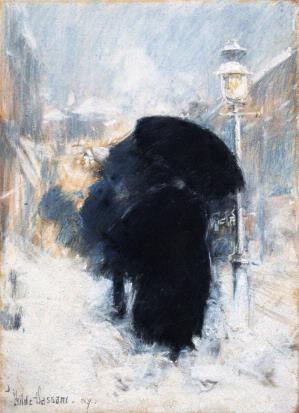
Childe Hassam, A New York Blizzard, 1890
Hassam is considered an American Impressionist. He worked in the mode pioneered by French Impressionists such as Claude Monet. Monet’s blue-shadowed snow paintings, such as The Magpie (below) set the tone for a blizzard of pale-gold-and-lavender landscapes still falling today.
Claude Monet
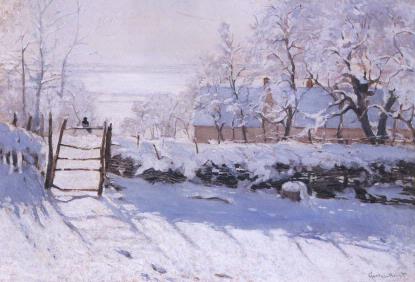
Claude Monet, The Magpie, 1868-69
While many American painters continue to paint snow in a manner rooted in the work of Monet and the Impressionists, here’s a notable European realist painter who made snow a specialty, Norwegian Peder Mørk Mønsted.
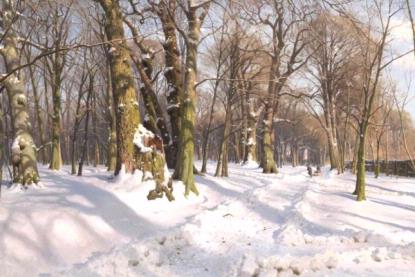
Peder Mørk Mønsted, Niveous Winter Forest in Sunlight, 1908
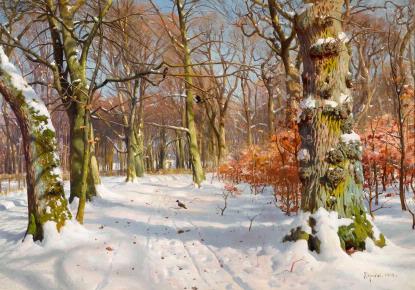
Peder Mørk Mønsted, ca. 1900
Our neighbors to the north have contributed gorgeous and striking snow-scapes to the genre. The paintings of Canadian Impressionist, Marc-Aurèle de Foy Suzor-Coté (1869 –1937) have the crusty surface texture of French bread and contain a wealth of subtle yet exceptionally lovely color harmonies.
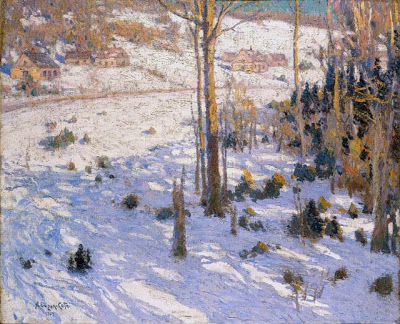
Suzor- Coté, Settlement on the Hillside, 1909
Willard Leroy Metcalf
Willard Metcalf (1858-1925) was a New Hampshire artist who excelled at depicting the snowy New England landscape. His landscapes are exceptionally well-composed.
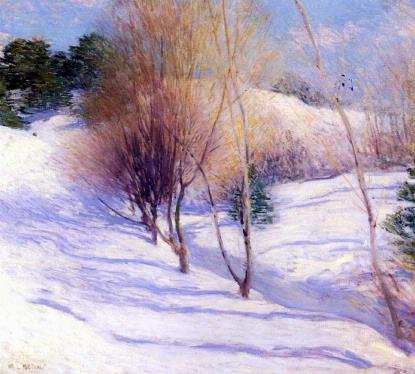
Willard Metcalf, the Winter in New Hampshire, 1913-14
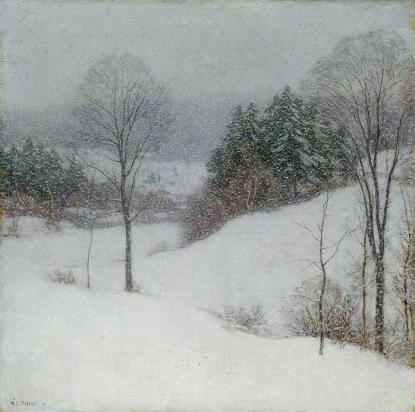
Willard Metcalf, The White Veil, 1909
Aldro Hibbard
Prominent Rockport, MA painter Aldro Hibbard (1886-1972) is still highly regarded for the strongly colored and boldly brushed landscapes he painted in Vermont during the winter.
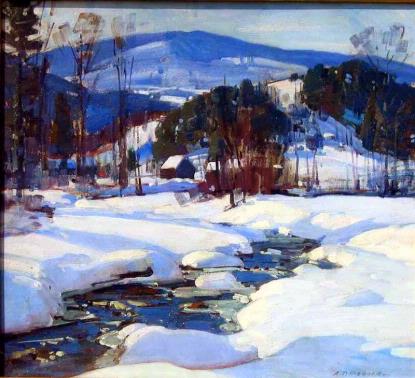
Aldro Hibbard, Winter landscape with river, ca. 1920
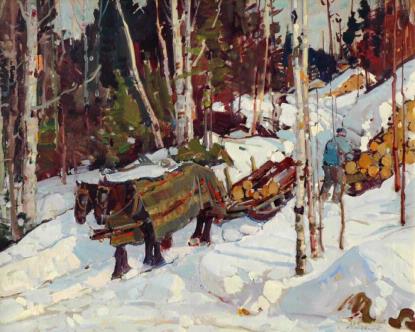
Aldro Hibbard, Loading on Logs, ca. 1920
Walter Launt Palmer
Walter Launt Palmer (1854-1932) appears on most artists’ list of great American snow painters. His snow-scapes are a tour-de-force of the scintillating play of wintry light and shadow, texture, and color. With a delicate intricacy, Palmer mastered the play between “warm and cool” colors, interlacing “cool” blues and violets with complementary “warm” oranges and yellows to create a sparkling, luminescent effect.
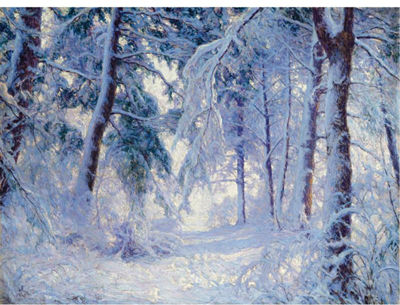
Walter Launt Palmer, Winter Forest, c. 1900
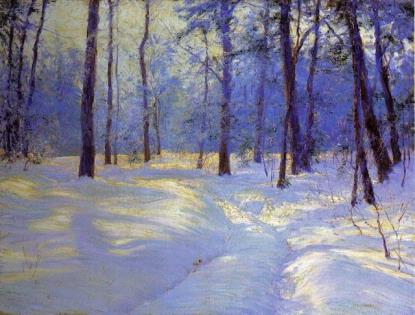
Walter Launt Palmer, Winter’s Glow, c. 1900
John F. Carlson
Palmer’s contemporary, John Carlson (1875-1947) became well known as a painter of snow scenes. He founded a painting school in Woodstock, New York, and published a handbook of landscape painting that is still essential reading for artists tackling the landscape today.
John F. Carlson, Forest Silence, ca. 1935
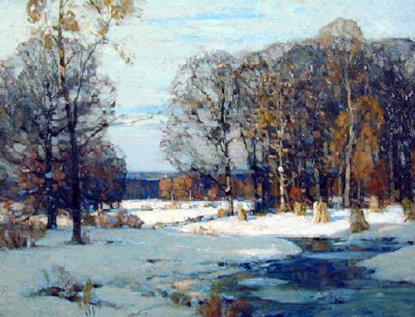
John F Carlson, Across the Meadows, ca. 1935
Frederick John Mulhaupt
After studying in Paris, Frederick John Mulhaupt (1871-1938) settled in Gloucester, MA, where he set up his own studio and set about winning prestigious awards from important art clubs, museums, and art associations. Like Carlson, he painted snow with an instinctual feeling for the “moods of nature.”
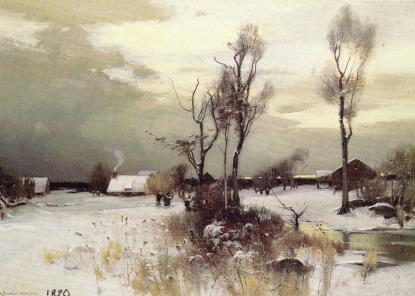
John Mulhaupt, A Snowy Homestead, 1890
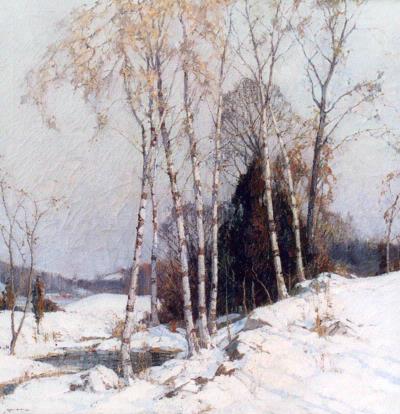
John Mulhaupt, Birches, ca. 1900
Andrew Wyeth
No discussion of New England snow painting should leave out Andrew Wyeth. Wyeth’s landscapes favor the starker contrasts and textures of his realist (as opposed to Impressionistic) orientation. “I prefer winter and fall, when you feel the bone structure of the landscape,” Wyeth said. “The loneliness of it, the dead feeling of winter. Something waits beneath it, the whole story doesn’t show.”
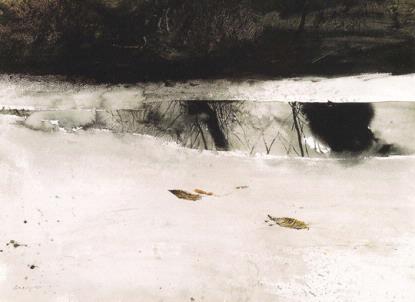
Andrew Wyeth, Ice Pool, 1969 (watercolor)
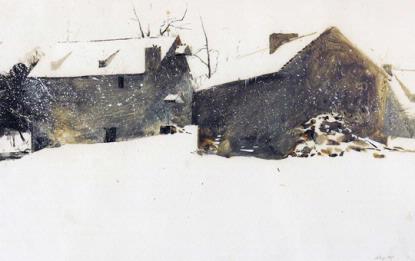
Andrew Wyeth, The Granary, 1961 (watercolor)
What have we missed? Do you have any favorite snow painters or paintings? If so, please share.
Christopher Volpe (www.christophervolpe.com) is a professional oil painter. You can view a larger selection of snow paintings, both historical and contemporary, on his art and art history blog. (www.christophervolpe.bogspot.com)


